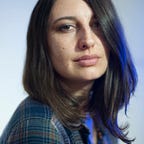None of These Trees Belong in San Francisco and Neither Do You and That’s OK
The Canary Island Palm. The London Plane. The Brisbane Box. Notice a pattern? Obviously, they’re three of the most common trees in San Francisco.
You’ve probably admired a Canary Island Palm by the Ferry Building, along the Dolores Street median, or hilariously decorated in red bows on the nicer stretches of Market during the holidays. The long fronds, crowning a stout trunk, are infamous for fooling tourists into forgetting their sweaters.
For years I felt sorry for the palms, imagining them on the brink of death as I walked down the Embarcadero with my wool scarf in July. I wondered what warmer clime they belonged in (I didn’t know their name then), and I wished I was there, too.
I moved to San Francisco for college in 2002, which qualifies me in the eyes of most people I meet as “from here.” I’m not, though. I grew up alternately in rural Sonoma County and rural New Mexico, and I feel at home in either the forest or the desert but less so on crowded sidewalks. I’ve lived in San Francisco longer than anywhere else but I’ve never really felt like I belonged.
In 2017–the year my car got broken into, my commute through SoMa became a campground, and I got to witness a man shooting heroin into his arm in broad daylight–I flailed desperately for a reason not to hate it here. I needed something to hang on to that had nothing to do with people–friends come and go here like the fog–and nothing to do with work, restaurants, or any kind of edifice. In fifteen years, almost every aspect of life in San Francisco has proven too impermanent to become attached to.
It was probably the effort to ignore human suffering and filth as I walked to work every morning that drew my attention to trees. Almost every block has its own small forest of them: evergreen, deciduous, mysterious. I started trying to identify them. The Mexican fan palm I knew, and there was one that looked a bit like a madrone but I wasn’t sure. Other than those, and the redwoods in Yerba Buena Gardens, I couldn’t guess the name of a single one. Where were our native California oaks, madrones, bays and redwoods? Why did the City of San Francisco insist on planting trees that weren’t from here, when the Bay Area has so many beautiful native trees? This, I realized, might be part of why San Francisco has never felt like home: it has none of the familiar species I associate with Northern California.
I asked my building manager what the madrone-like trees on our sidewalk were. Lophostemon confertus, the Brisbane box. An Australian tree. I looked up the distinctive, malformed deciduous trees outside City Hall — the ones with knobby branches and dappled bark. Platanus x acerifolia, the London plane, is a hybrid from Europe that gets pruned in an unusual way called pollarding. I googled the fat, sad palms along the Embarcadero. They were Phoenix canariensis, the Canary Island palm, from the eponymous archipelago near Morocco.
Where were the natives?
Once I realized that the strangeness of the trees might be contributing to my own feeling of being a stranger, I set out to become acquainted with them. This quest led me to a book called The Trees of San Francisco, by Michael Sullivan. I forgave it for using Zapfino on the cover as soon as I read the first entry. An hour later I was halfway through, and I had learned something that, for the first time in my fifteen years in this city, made me feel like maybe I belonged. It was for a reason I never expected.
Before Salesforce Tower emerged in our skyline like a giant middle finger to the East Bay, before the new Federal Building in its metal sweater went up at Mission and Seventh, before the Canary Island Palms replaced a freeway along the Embarcadero, before there was a prison in the middle of the Bay and before the Golden Gate was synonymous with a bridge, this seven-mile-wide peninsula was covered in sand dunes and shrubs from bay to sea. There were some wildflowers, a few small manzanitas, and maybe a California Buckeye or two. The sandy soil and uniquely cold, damp summers differentiated the peninsula so much from the rest of Northern California–the only place I’ve lived with a season called “fire”–that none of the Bay Area’s native trees can grow here.
So basically, and fittingly, none of the trees in San Francisco are from here. The olive and ficus, cherry blossom and strawberry tree (yes that’s its real name), eucalyptus and ginko–they’re all from someplace else. Like me. Like you.
In a city where not even the trees belong, I’m going to go out on a limb and say: we all do.
If you want to learn more about San Francisco’s unique and diverse treescape, I recommend following Friends of the Urban Forest, a local nonprofit dedicated to our “green infrastructure.” I also highly recommend iNaturalist if you find yourself wondering, like me, “What tree is that?” Just upload a photo and if the app’s image recognition can’t tell you, its global community of naturalists can.
